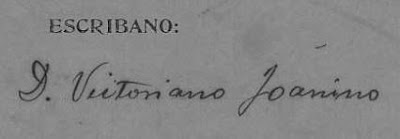Father Vilallonga is the only one in a black cassock (besides Bishop Oláiz), standing on left
In 1929, the Pope sent a Spanish Jesuit with an impressive resumé to inspect the mission of Guam. His name was Father Joaquín Vilallonga.
He arrived in late 1929 and after his visit with Bishop Oláiz and the Capuchin missionaries, all Spaniards like himself, he gave the Guam mission not merely a clean bill of health but high praise, calling it the "best organized mission in Oceania."
Here's what Vilallonga said himself in a letter to Bishop Oláiz of Guam :
"I can say with total sincerity that I have not found in all the Philippines a mission better organized than that which the Capuchin Fathers have in Guam under the prudent and wise direction of Your Excellency. I believe that the Chamorros can consider themselves very content and happy in having such zealous and selfless missionaries who give to all their faithful such good examples of virtue and holiness."
The very positive report on Guam filed in Rome by Vilallonga helped move the Vatican to send money to Bishop Oláiz so that he could build a two story concrete building to house many Catholic activities.
What were his credentials that allowed him to act as inspector for the Vatican?
VILALLONGA THE YOUNG MISSIONARY
Like many Jesuits, Vilallonga's dream was to work in the missions. After joining the Jesuits in Spain in 1885 at the age of 17, he was sent to Manila in 1892 to teach at the Ateneo de Manila. He taught philosophy, physics and mathematics. He was well-educated in the Latin classics, and could recite from memory long passages from Cicero and Virgil. He was good in the Greek classics, too.
WITNESS TO HISTORIC TIMES IN MANILA
Vilallonga lived in the same Jesuit residence in Intramuros, Manila where some of his Jesuit confreres lived; Jesuits who visited José Rizal in prison. They would come back to the house asking the Jesuit community to pray for their former student.
When Admiral Dewey sailed into Manila Bay in 1898 during the Spanish-American War, Vilallonga was eyeing the American fleet from atop the Jesuit house in Intramuros.
A BUSY LIFE IN HIGH POSITIONS
He was sent to St. Louis, Missouri to finish his studies and there learned to speak English well. He also became friends with Teddy Roosevelt and John D. Rockefeller. The story is that Vilallonga defended his thesis in front of a crowd that included Roosevelt, who was impressed enough to send him a written note of congratulations. Finishing his studies in the U.S., he returned to Manila and began a quick rise to positions of authority :
Rector of the Ateneo de Manila 1910
Superior of the Davao Mission 1917
Rector of the Vigan Seminary in 1920
Superior of the Jesuits in the Philippines in 1921
Provincial Superior of the Jesuit Province of Aragon (Spain) in 1926
It was because of these extensive experiences in missionary life that Vilallonga was an excellent choice of Rome to conduct an official inspection of the Church in the Philippines and in Guam. He could deal with the many Spanish missionaries, and his command of English and acquaintance with American ways enabled him to relate well with the American civil and military authorities.
When that was done, he was back in the missions but this time in India, where he worked from 1930 to 1949. It was in 1949, at the age of 81, that Vilallonga made a surprising request of his superiors. It concerned his next assignment!
CHAPLAIN TO THE LEPERS AT CULION
Fr. Vilallonga visits his people at the leprosarium in Culion.
At age 81, many priests look forward to a life of blessed retirement. Not Vilallonga. Having occupied very high offices in the past - in academic and religious governance - he wanted his "last stop" to be in a remote corner of the Philippines called the "Island of No Return" among those suffering from Hansen's Disease. There he would say Mass for them, hear their confessions, anoint them, listen to them, attend to their needs, be a father and friend to them.
In 1949, there were undoubtedly patients from Guam who had come there many years before. They must have jolted Vilallonga's memories of his short time on Guam. I am sure, when he conversed with Guam patients, he brought up the name of at least Bishop Oláiz and perhaps one or two friars.
Vilallonga wanted to die in Culion and be buried with the lepers, without a casket. His noble aspiration was not God's will, though. In 1962 his physical condition necessitated a move to Manila where he died the following year. He was buried in the cemetery of the Jesuit novitiate in Novaliches.
MAGSAYSAY AWARD
In 1959, Vilallonga won the Ramon Magsaysay Award for Public Service. He was the second person to win this award since its inception in 1957. It was his work with the lepers of Culion that earned him this distinction.
Vilallonga receiving the Magsaysay Award. Cardinal Santos stands to the left.
Vilallonga with the dignitaries....
Claro M. Recto
Statesman, writer, jurist
and his former student
and his former student
...and the needy.
Spiritual guidance with a patient in Culion
REMEMBERED IN HIS NATIVE PLACE
It is ironic that a man who left his home was honored by the people of his birthplace who hardly ever saw him. Even a nephew of his spoke about the great "absence" of his uncle in the family, since he spent the majority of his life overseas. The year after he died, his native town of Burriana, Valencia opened a school in his honor. In 2014, the school celebrated its 50th anniversary and unveiled a plaque in his honor.













